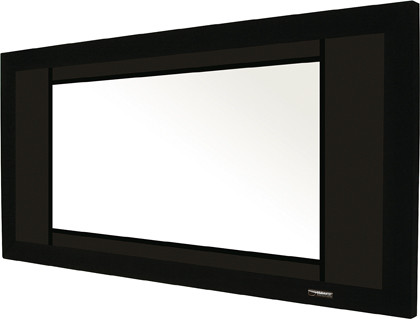Home cinema projection screens: how to choose
Which type, size and aspect ratio is best for you?
Choosing the correct size is more complicated than you might think. Aside from the size of your wall you need to consider at what distance from the screen your audience will sit, which is down to personal preference.
When people go to the movies some like to be relatively near the front, others prefer the back, while some will only sit the middle. And so it is at home, where people like to have different screen sizes relative to their preferred viewing position.
Screen size also depends to some extent on the quality of your projector and screen. If neither is particularly good, sitting too close will only make you more aware of the shortcomings.
Finally, it's a simple fact that how large a screen your projector can drive is dependent on the amount of brightness its lamp can produce. So while 'light cannons' such as Sim2's spectacular C3X Lumis can drive screens many hundreds of inches across, you might find relatively low brightness projectors struggling to keep images looking punchy over 80-100in.
We mentioned screen material earlier and it's this aspect of screen selection that's the most bewildering yet, potentially, crucial.
The first decision you need to make is quite simple: do you want to mount any speakers behind the screen? If so, you'll need an acoustically transparent, perforated fabric that enables sound to pass through without becoming muffled or blocked. Such fabric can cause problems with reduced brightness and back wall light reflections, as light passes through the acoustic holes.
No pain, no gain
Sign up for breaking news, reviews, opinion, top tech deals, and more.
After this basic decision, though, life gets more complicated. For a start, you have to get grips with the concept of gain. Some screens are high gain, while others are low, with all sorts of ratings in between, and each gain value has its place.
Many white home cinema screens tend to be low gain, with values written as 1.0-1.3. these gain figures, rather archaically, describe the ratio of light a screen reflects in relation to the amount of light that gets reflected by an untreated magnesium oxide board. so a 1.3 gain screen will reflect around 30 per cent more light than our lovely magnesium oxide white board.
The growing interest in black-level boosting screens that use a grey material rather than white is resulting in gain figures below 1.0 appearing, too. The question of whether you should get a high or low-gain screen, again boils down to matters of taste and, more importantly, room setup.
For instance, high-gain screens have reduced viewing angles versus low-gain ones, which could be an issue if viewers will have to sit to the side of the screen. High-gain screens can suffer from hot spots too, where the centre of the image looks brighter than the rest. And finally, high-gain projection panels can damage colour balance, since they don't reflect red, green and blue equally from all viewing angles.
But before you discount them, if there's often a degree of ambient light in your movie room, the high-gain variety could be essential. In fact, a few have been developed now with extreme gain properties, specifically to try and emulate (for a fraction of the cost) the performance of, say, a massive (80in plus) plasma screen in a normal living room environment.
A particularly outstanding example of this is the screen Innovations Black Diamond II we tested in issue 183.
Dedicated, blacked out home cinema rooms might be better with more standard-gain screens, though, and possibly even a grey sub-1.0 gain screen. Grey screens were extremely worthwhile a few years ago before projectors started to produce impressive contrasts, but they arguably still have a place even if you've got a good high-contrast projector.

If your viewing room is either decorated in light coloured finishes or else houses numerous light furnishings, the way grey screens stop light bouncing around a room could prove very useful.
One final consideration is the issue of the quality, finish and weave of the screen you buy. We've heard various cynics suggest that expensive screen materials don't really make a difference. But this is just plain wrong. We've seen first-hand how some screens really can produce sharper, more detailed images with HD than others.
Also, some screens can cause a slight moiré effect over areas of fine detail while others don't. Some screens, as previously discussed, are brighter and more reflective than others, and some are better at reproducing a convincing black colour. Some diffuse light right around your room for wide viewing angles, while others focus it right back at you. Some reproduce colours completely neutrally (and thus accurately), others can introduce an underlying tinge of their own or favour certain tones over others, leading to an unbalanced colour palette.
We're even starting to see screens appearing now that claim to be better for 3D than others. This might seem spurious at first glance, but actually stereoscopic pictures need utter clarity for high levels of detail and really accurate colour toning to become convincing, so we can understand some screens working better with the technology than others.
One of the first screens designed and tested with 3D in mind is Image screen's Cadre 3D.
Finally, the basic quality of the fabric in terms of wear and tear, hanging weight and resilience to rolling, with roll-away projectors, can have a massive impact on long-term viewing. You would be well advised to get help from custom installation experts before finally settling on a screen.
And try to partner your projector with a screen of as much quality as you can afford. After all, unlike a TV, a high quality screen should last you a lifetime.
- 1
- 2
Current page: Choosing the correct projection screen size
Prev Page How to choose a home cinema projection screen
John has been writing about home entertainment technology for more than two decades - an especially impressive feat considering he still claims to only be 35 years old (yeah, right). In that time he’s reviewed hundreds if not thousands of TVs, projectors and speakers, and spent frankly far too long sitting by himself in a dark room.